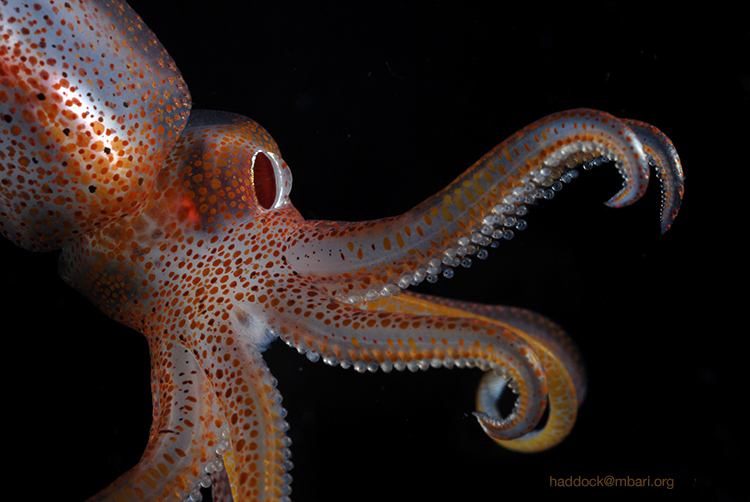Meet the Cock-Eyed Squid
This midwater cephalopod sports different-size eyes for different functions.

A cock-eyed squid known as the "strawberry squid." Photo by Steven Haddock
In the midst of “the twilight zone”—the ocean realm ranging from 200-1,000 meters below the surface—roams this small cephalopod.
This is a species of cock-eyed squid, whose scientific name, Histioteuthis heteropsis, means “different eyes.” “They have that one eye that looks about proportional to the body, and then the other eye is about twice the diameter on the other side,” says Steven Haddock, a marine biologist at the Monterey Bay Aquarium Research Institute. The members of the cock-eyed squid family are the only squids known for such distinctive oculi.

“It’s thought that each eye serves a different function,” says Haddock. While the small eye might watch for dangers emerging from the depths, the big eye—which can better detect details—looks upward, where it can catch sight of shadows cast by prey swimming above, according to Richard Young, emeritus professor of oceanography at the University of Hawaii.
“They live in a depth where there’s just some very faint light coming down,” says Young. “By casting a shadow, [prey are] giving their position away.”
But many midwater animals employ methods to escape detection, including a process known as counterillumination. Using light-emitting organs called photophores located along their body, these creatures can generate light that matches the color and intensity of downwelling sunlight, thereby obscuring their shadows.
The cock-eyed squid, however, has evolved an ability to detect animals that counterilluminate. As the cephalopod’s big eye develops, the lens can become tinted yellow. That pigment acts as a filter for blue light, says Haddock. (The eye also fluoresces, but Haddock says that’s probably just a side effect of the pigment. Check out the video above.)
As the theory goes, the yellowish orb enables the squid to spy an animal above whose counterillumination doesn’t perfectly match blue, downwelling light. “If it’s, say, a little too green or a little yellow or something, it will stand out against a very black background,” and therefore be visible to the squid, explains Young.
This cock-eyed squid can also counterilluminate. The density of its photophores—the speckles seen along its body—and its reddish color led Haddock to use another nickname for the cephalopod: “I like to call [it] the strawberry squid.
With every donation of $8 (for every day of Cephalopod Week), you can sponsor a different illustrated cephalopod. The cephalopod badge along with your first name and city will be a part of our Sea of Supporters!
Chau Tu is an associate editor at Slate Plus. She was formerly Science Friday’s story producer/reporter.